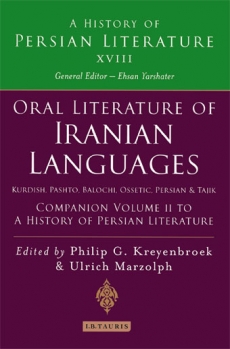| Éditeur : I.B.Tauris | Date & Lieu : 2010-01-01, London |
| Préface : | | Pages : 247 |
| Traduction : | ISBN : 978-1-84511-918-8 |
| Langue : Anglais | Format : 145x225 mm |
| Code FIKP : Liv. Ang. 3386 | Thème : Linguistique |
|
Présentation
|
Table des Matières | Introduction | Identité | ||
 Oral Literature of Iranian Languages In the 1990s I gradually became convinced that the time had come for a new, comprehensive, and detailed history of Persian literature, given its stature and significance as the single most important accomplishment of the Iranian peoples. Hermann Ethé’s pioneering survey of the subject, “Neupersische Litteratur” in Grundriss der iranischen Philologie II, was published in 1904 and E.G. Browne’s far more extensive A Literary History of Persia, with ample discussion of the political and cultural background of each period, appeared in four successive volumes between 1902 and 1924. The English translation of Jan Rypka’s History of Iranian Literature, written in collaboration with a number of other scholars, came out | |||||
| Preface
Those whose views on literature are informed by traditional definitions of the concept, may regard this Companion Volume as less of a desideratum. The fact that two only partially related fields of study—on the one hand oral and popular literature in various forms of Persian, and on the other the whole range of literary traditions of the Kurds, Pashtuns, Baloch and Ossetes—are included in one volume, may at first glance seem to strengthen the impression that these subjects are of no more than marginal relevance to those interested in the literatures and civilizations of the Middle East and Central Asia. A closer examination, however, shows both the criss-crossing web of interrelations between the “high” and “popular” literatures discussed in this volume, and their links with the classical Persian tradition, with which this History is chiefly concerned. Moreover, although the study of the subjects discussed here has long occupied a relatively marginal position within the wider field of Iranian Studies, in the context of a modern approach to Oriental Studies their relevance is now increasingly understood. Not only is the information these studies offer essential for a more realistic understanding of the countries and regions in question, but research in relatively unexplored fields of study has also had the advantage of forcing academics to explore new, modern methods of study. Much of the information contained in the contributions to this volume is published here for the first time, and the work may confidently be expected to facilitate and stimulate future research. However, the task that faced the present contributors, viz. systematizing, describing, and contextualizing the bewildering mass of information that had so far been left unstudied, is only a first step. In order to realize the full potential of Oral and Popular Studies and the study of “minority” literatures generally, methods must be developed to enable us to interpret the material in ways that .....
| ||||